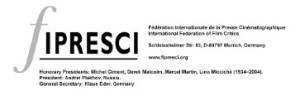Maria Augusta Ramos "Behave": the law of the documentary,
a documentary about the law.
By Gabriele Barrera
Law and order. Rigorous silence, black on the screen, an opening verdict. Maria Augusta Ramos
“The Brazilian Law prohibits exposing the identity of underage offenders. In
this film, these offenders were substituted by youngsters from three favelas
in Rio de Janeiro, who live within the same circumstances of violence and
social marginalization. All other characters and institutional facilities depicted
in this film are real”. This is the cinematographic-law of Behave (Juízo,
Brazil 2007), the last work by Maria Augusta Ramos, an absolutely promising documaker,
born in Brasilia, in 1964. She’s graduated from the NFTA – Netherlands
Film and Television Academy, in 1990. Afterwards, she’s director,
writer and also editor of some astonishing documentaries, like the hypermeticulous
and hypersensitive Brasilia, A Day in February, 1995, awarded in
the Brasilia Documentary Festival. And more: Desi, 2000, another awardwinning
chilling documentary of the Ducth adolescent’s tribulations, in 2
competition in the Amsterdam Documentary Festival. Anything else? Yes:
Justice, 2004, an impressive hybrid of feature-film and documentary-film
with an intimate (and above all not-judging) look inside the Brazilian justice
system (an injustice system or even better: a powerless justice system, like
in a nightmare social-maze). Justice, in the same year, wins the Grand Prix
Visions du Réel, in Nyon.
The behaviour of Behave
Finally, it’s the time of her masterpiece: Behave, winner of the FIPRESCI
Prize, now, at the 50th DOK Leipzig 2007 - International Leipzig Festival for
Documentary and Animated Film. It’s a new sharp remark about the life trajectory
of the Rio de Janeiro’s under-18s in front of the law (and in front of
the Maria Ramos’ camera, in its turn totally rigid and totally helpless in
front of the inexorable presence of the violence in the Brazilian society,
from the favelas to the prison, from the prison to the favelas, ad libitum).
3
The real responsability of this violence, in the Brazilian society – so it appears
-, is delegated (and projected) to a justice system obsessive, but (in spite
of appearances) a justice system totally fake, useless, like a labyrinthine
loop. Then, at the same time, Maria Ramos underlines the power and the
powerless of the docu-view. The illusion of the reality, perhaps the manipulation
of the reality. At the same time, the helplessness in front of the reality
and its fate. Is it a bright, kubrickian-paradox of the real law of the documentarism?
Yes, maybe.
“Is it true that on the 21st of January you and Alex ran up to the victim
while she was biking, Alex saying: give us the bike?”, asks with an implacable
and robotic speech the (real) judge of Behave to the (fake: he’s a notprofessional
actor!) young boy investigated. On the Behave’s movie-poster,
a young boy investigated shows his face with a black plaster in the place of
the eyes: it’s the law for the under-18s. Conversely, the Maria Ramos’ camera-
eye, for the whole journey in the maze of Behave, shows without the
plaster the eyes of her (fake) under-18s, and all of a sudden she shows another
amazing paradox of the docufiction. Oddly, all the real characters –
judges, prosecutors, attorneys, agents from the DEGASE, also known as State
Socio-educational Department, family members, agents of the prison for
minors Padre Severino – and all the reality ring false. Instead, all the actors
and all the fiction ring true. Strange. Or not?
4
Behave: b for be fake, b for be true
For example: the (fake) teenage-boy culpable and sentenced for parricide?
“A shocking piece of reality”, the spectator thinks. It’s wrong: the spectator
is sentenced to review (to re-review) Behave. And the (real) judge? “An
extraordinary actress, cruel and merciful at the same time”, the spectator
says. It’s wrong: she’s a (true) judge, but also a theater-machine, like the
(true) sergeant Lee Ermey of Full Metal Jacket (1987: again a kubrickian
movie, again a paradoxal work). With a movie by Fernando Meirelles (City
of God, 2002, in the bairro labirintico of Rio, for example) the social violence
stylistically blows up. With Maria Ramos the violence implodes, worse
and worse. The historical heritage of the Brazilian Chancada is totally finished,
of course, but – surprisingly – the historical heritage of the Eztétyca
da Fome by Glauber Rocha (1965) is finished too. And so?
And so: “Is it true that…”. “Ramos is a master of objective eye”, writes Jay
Weissberg on Variety. True? Objective? Impossible to say. It’s the Leitmotiv
of Behave: truth and fiction are in a visual maze. And so, goodbye to the
5
André Bazin’ réalisme ontologique, goodbye to the montage interdit (see,
evidently, Qu’est-ce que le cinéma. Ontologie et langage, 1958). Indeed,
the cinematographic law of Ramos’ Behave is radically different. The shot is
real, the reverse-shot is fake, all in the same fluent, undistinguishable docu-
fiction-speech. Not only a paradox, but – that’s the point! – it’s a brilliant
linguistic mirror of the Brazilian society: the fluent, undistinguishable
shots and reverse-shots of the innocence and the guilt, of the civil society
and the violent “full-metal-racket” of the favelas in Rio de Janeiro. To make
judgments about the Brazilian judge system (or, perhaps, about all the
judge systems), after the vision of Behave? It’s very hard to do. We don’t
have to behave like judges. Luckily for us.
Gabriele Barrera
© FIPRESCI 2007
Gabriele Barrera is a teacher, journalist and film critic in Italy for "Duellanti", "Nick
Film TV", "Cinecritica", "Best Movie" and "Maxim Italia". He also teaches "History of Cinema"
at the Gramsci Institute in Turin, "Basic Language of Cinema", and writes essays
and books: "From Umberto D to Europa 51" (2000), "Mario Bava: The Beauty is the Beast"
(2002), "The Excess of the Vision" (2003), "Urban Simulations" (2006), “Movie Stars”
(2007).
website: Maria-Ramos
